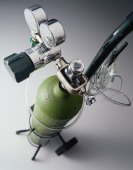
FRIDAY, Sept. 3 (HealthDay News) — Oxygen therapy may be unnecessary for some terminally ill people who have trouble breathing, and could be replaced by treatment with ordinary room air, a new study suggests.
People who are near death often experience breathlessness, and the condition is common in terminally ill patients with conditions such as heart failure, lung cancer and chronic obstructive pulmonary disease, the study authors explained in the report published online Sept. 4 in The Lancet.
Oxygen therapy is normally used when people have low levels of oxygen in their bodies. But in terminally ill people, it’s sometimes used even when their oxygen levels aren’t dangerously low, Dr. Amy Abernethy, of Duke University Medical Center, and colleagues pointed out in a university news release.
In the study, the investigators randomly assigned terminally ill patients with breathlessness to receive treatment with oxygen or normal room air through prongs in the nose. The patients were told to take treatment for at least 15 hours a day. A total of 211 patients completed seven days of treatment.
The researchers found that there wasn’t a statistically significant difference between the groups of patients in regards to breathlessness levels.
“Less burdensome strategies should be considered after brief assessment of the effect of oxygen therapy on the individual patient,” the study authors concluded.
The study is valid and suggests the value of using room air instead of oxygen in some cases, Dr. R. Sean Morrison, director of the National Palliative Care Research Center at Mount Sinai School of Medicine in New York City, who was not involved with the study, said in an interview.
In addition to being expensive and often not covered by insurance, oxygen therapy “requires specialized equipment and can create anxiety about getting tanks refilled in time,” Morrison said.
Still, he added, “we do know that in the setting of oxygen deficiency, oxygen is beneficial.”
More information
For details about oxygen therapy, visit the U.S. National Heart, Lung, and Blood Institute.

